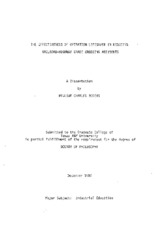| dc.contributor.advisor | Dennis, Maurice E. | |
| dc.creator | Rogers, William Charles | |
| dc.date.accessioned | 2020-08-21T22:04:19Z | |
| dc.date.available | 2020-08-21T22:04:19Z | |
| dc.date.issued | 1980 | |
| dc.identifier.uri | https://hdl.handle.net/1969.1/DISSERTATIONS-643232 | |
| dc.description | Typescript (photocopy). | en |
| dc.description.abstract | Operation Lifesaver is an education, enforcement, and engineering program designed to reduce accidents at railroad-highway grade crossings. There are more than 400,000 public and private grade crossings in the United States, and these are the sites of 1,000 fatalities and 12,000 accidents annually. The reported research analyzed the results of the Operation Lifesaver programs in Illinois and Georgia, as compared to the accident experience in California and North Carolina--states that did not implement Operation Livesaver. In addition, the accident experience of Illinois was evaluated against the United States (with other Operation Lifesaver states subtracted) as a further comparison. The impact of Operation Lifesaver was analyzed using the Box-Jenkins time series analysis. The results of the research showed a significant reduction of 34.36 accidents per month in Illinois after the implementation of Operation Lifesaver, while California had a non-significant reduction of 3.03 per month during the same time. Neither state showed a significant reduction in grade crossing fatalities. Georgia experienced a significant reduction of 2.46 fatalities per month after the introduction of Operation Lifesaver, while North Carolina had a non-significant reduction of 0.57 fatalities per month during the same time. Because of reporting changes, it was impossible to measure the impact of Operation Lifesaver on grade crossing accidents in Georgia. The results of the comparison of the accident experience of Illinois with the United States showed a significant reduction of 34.36 accidents per month in Illinois, as compared to an increase of 9.84 accidents in the United States during the same time. The research concluded that Operation Lifesaver reduced railroad-highway grade crossing accidents in Illinois and fatalities in Georgia. For these reasons, the national adoption of this program is recommended. | en |
| dc.format.extent | xi, 119 leaves | en |
| dc.format.medium | electronic | en |
| dc.format.mimetype | application/pdf | |
| dc.language.iso | eng | |
| dc.rights | This thesis was part of a retrospective digitization project authorized by the Texas A&M University Libraries. Copyright remains vested with the author(s). It is the user's responsibility to secure permission from the copyright holder(s) for re-use of the work beyond the provision of Fair Use. | en |
| dc.rights.uri | http://rightsstatements.org/vocab/InC/1.0/ | |
| dc.subject | Major industrial eduation | en |
| dc.subject.classification | 1980 Dissertation R731 | |
| dc.subject.lcsh | Operation Lifesaver | en |
| dc.subject.lcsh | Traffic safety | en |
| dc.subject.lcsh | Railroad crossings | en |
| dc.subject.lcsh | Railroad accidents | en |
| dc.title | The effectiveness of operation lifesaver in reducing railroad-highway grade crossing accidents | en |
| dc.type | Thesis | en |
| thesis.degree.grantor | Texas A&M University | en |
| thesis.degree.name | Doctor of Philosophy | en |
| thesis.degree.name | Ph. D | en |
| dc.contributor.committeeMember | Barker, Donald G. | |
| dc.contributor.committeeMember | Boone, James | |
| dc.contributor.committeeMember | Van Riper, Paul | |
| dc.type.genre | dissertations | en |
| dc.type.material | text | en |
| dc.format.digitalOrigin | reformatted digital | en |
| dc.publisher.digital | Texas A&M University. Libraries | |
| dc.identifier.oclc | 7873598 | |


